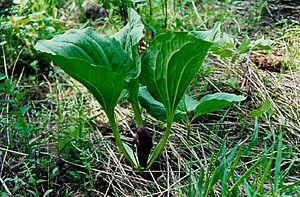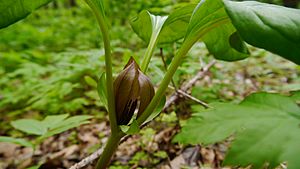Long-petioled trillium facts for kids
Quick facts for kids Long-petioled trillium |
|
|---|---|
 |
|
| Scientific classification | |
| Genus: |
Trillium
|
| Species: |
petiolatum
|
| Synonyms | |
|
|
The Idaho trillium (Trillium petiolatum) is a special flowering plant found in the northwestern United States. You can spot it in Idaho, Oregon, and Washington. It's also known as the long-petioled trillium or round-leaved trillium. This unique plant was first discovered by Meriwether Lewis in 1806 near the Clearwater River during his famous Lewis and Clark Expedition.
Contents
What Makes the Idaho Trillium Special?
The Idaho trillium is quite unusual compared to other trillium plants. Its scientific name, petiolatum, means "petioled." This refers to its very long leaf stems, called petioles. These stems can be about 5 to 12 centimeters (2 to 5 inches) long. They are almost as long as the leaf blades themselves! The leaves are round or oval shaped. They are green and do not have any spots. These leaves look a lot like those of a common plantain.
Unique Features of the Plant
The main stem of the plant, called a scape, is about 4 to 17 centimeters (1.5 to 7 inches) long. But most of it stays hidden underground. This is because the plant's root system, called a rhizome, grows deep in the soil. This deep growth likely helps protect the plant.
Because of this, the leaves and the flower grow very close to the ground. The flower is small. Its outer leaf-like parts, called sepals, are about 22 to 47 millimeters (0.9 to 1.9 inches) long. The colorful petals are about 30 to 55 millimeters (1.2 to 2.2 inches) long. These petals can be red, maroon, or purple. Sometimes, you might even find yellow ones! Because of its small size and unusual leaves, this plant can be hard to spot.
The Idaho trillium shares some traits with other trilliums. For example, it has leaves with petioles like the prairie trillium (T. recurvatum). However, it seems more closely related to T. sessile based on its flower parts.
Where Does the Idaho Trillium Live?
This plant blooms early, from April to late May. The exact time depends on the weather and how high up it grows. It might even bloom earlier on sunny, south-facing hillsides. You can find it growing at elevations from 400 to 1400 meters (1,300 to 4,600 feet). It often grows near stream beds, under small bushes, and at the edges of forests.
The Idaho trillium is very tough. It can survive in harsh conditions where other trillium species cannot. Only a close relative, Pseudotrillium rivale, lives in similar open and dry places. Unlike some other trilliums, the Idaho trillium does not grow well in gardens in the eastern United States.
Life Cycle of the Trillium
Like other trillium plants, the Idaho trillium has different growth stages. First, it starts as a single-leaf plant. After that, it grows into a three-leaf plant, which is its young stage. After several years of growing leaves, the plant finally reaches its flowering stage. At this point, it will also have three leaves. This plant can live for many, many years.


